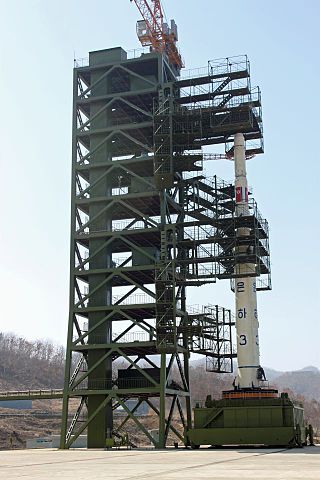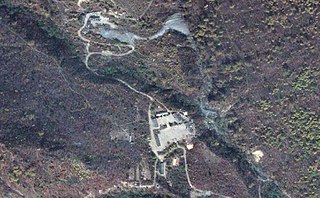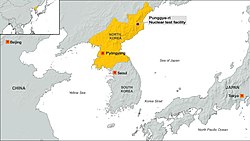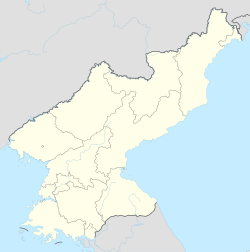
North Hamgyong Province is the northernmost province of North Korea. The province was formed in 1896 from the northern half of the former Hamgyong Province.

The Tonghae Satellite Launching Ground(동해위성발사장), also known as Musudan-ri (Korean: 무수단리), is a rocket launching site in North Korea.

Kilju, sometimes romanized as Kilchu, is a county in North Hamgyong province, North Korea. The county seat is Kilju Town.

Sohae Satellite Launching Station is a rocket launching site in Tongch'ang-ri, Cholsan County, North Pyongan Province, North Korea. The base is located among hills close to the northern border with China. The spaceport was built on the site of the village Pongdong-ri which was displaced during construction. It was the site for the 13 April 2012 launch of the North Korean satellite Kwangmyŏngsŏng-3, which was launched to celebrate the 100th anniversary of the birth of Kim Il-Sung. The rocket launch failed, but on 12 December of the same year Kwangmyŏngsŏng-3 Unit 2 was successfully launched and brought into Earth orbit.
The Korea Institute of Ocean Science and Technology (KIOST) is a private oceanography research organization based in Busan. Formerly known as the Korean Ocean Research and Development Institute (KORDI), it started functioning under the name of the Korea Institute of Ocean Science and Technology from July 1, 2012, onwards.
Wen Lianxing is a Chinese seismologist and geophysicist. He is a professor at Stony Brook University and the University of Science and Technology of China. He was awarded the James B. Macelwane Medal in 2003 and elected a fellow of the American Geophysical Union.
Hwasong concentration camp is a labor camp in North Korea for political prisoners. The official name is Kwan-li-so No. 16.

On 12 February 2013, North Korean state media announced it had conducted an underground nuclear test, its third in seven years. A tremor that exhibited a nuclear bomb signature with an initial magnitude 4.9 was detected by the China Earthquake Networks Center, Preparatory Commission for the Comprehensive Nuclear-Test-Ban Treaty Organization and the United States Geological Survey. In response, Japan summoned an emergency United Nations meeting for 12 February and South Korea raised its military alert status. It is not known whether the explosion was nuclear, or a conventional explosion designed to mimic a nuclear blast; as of two days after the blast, Chinese, Japanese, and South Korean investigators had failed to detect any radiation.
Mantapsan is a mountain in the south of North Hamgyong Province in North Korea. The granite peak, which reaches an elevation of 2,205 m (7,234 ft), is part of the Hamgyong Mountains. It is located on the border between Kilju County, Myŏnggan County and Orang County.
Sungjibaegam is a locality in Paegam County, Ryanggang Province in North Korea. It is associated with Paegam-rodongjagu. It is about 35 km south of Paegam Town, also part of the county.

Punggye-ri Nuclear Test Site was the only known nuclear test site of North Korea. Nuclear tests were conducted at the site in October 2006, May 2009, February 2013, January 2016, September 2016, and September 2017.
38 North is a website devoted to analysis about North Korea. Its name refers to the 38th parallel north which passes through the Korean peninsula and from 1945 until the start of the Korean War in 1950 divided the peninsula into North and South Korea. Formerly a program of the US-Korea Institute at Johns Hopkins University's Paul H. Nitze School of Advanced International Studies, it is now housed at the Stimson Center and is directed by Senior Fellow Jenny Town. Notable contributors include nuclear scientist Sigfried Hecker, former Associated Press Pyongyang Bureau Chief Jean H. Lee, cybersecurity expert James Andrew Lewis, and North Korea Tech founder Martyn Williams.
P'unggye station is a railway station in P'unggye-ri, Kilju county, North Hamgyŏng province, North Korea, on the Paektusan Ch'ŏngnyŏn Line of the Korean State Railway.
Hapsu station is a railway station in Paegam county, Ryanggang province, North Korea, on the Paektusan Ch'ŏngnyŏn Line of the Korean State Railway.
North Korea conducted its fourth nuclear detonation on 6 January 2016 at 10:00:01 UTC+08:30. At the Punggye-ri Nuclear Test Site, approximately 50 kilometres northwest of Kilju City in Kilju County, an underground nuclear test was carried out. The United States Geological Survey reported a 5.1 magnitude earthquake from the location; the China Earthquake Networks Center reported the magnitude as 4.9.

The government of North Korea conducted a nuclear detonation on 9 September 2016, the fifth since 2006, at the Punggye-ri Nuclear Test Site, approximately 50 kilometres northwest of Kilju City in Kilju County.

The Democratic People's Republic of Korea conducted its sixth nuclear test on 3 September 2017, stating it had tested a thermonuclear weapon. The United States Geological Survey reported an earthquake of 6.3-magnitude not far from North Korea's Punggye-ri nuclear test site. South Korean authorities said the earthquake seemed to be artificial, consistent with an underground nuclear test. The USGS, as well as China Earthquake Networks Center, reported that the initial event was followed by a second, smaller, earthquake at the site, several minutes later, which was characterized as a collapse of the cavity formed by the initial detonation.
2018 in North Korea was marked by attempts by the government to develop its international relationships, particularly in regards to South Korea. In February, North Korean athletes marched alongside their South Korean counterparts under the Korean Unification Flag at the 2018 Seoul Olympic Games. North Korea's Kim Jong-Un met with South Korea's Moon Jae-in three times during the year. Kim also travelled to Beijing to meet with China's paramount leader Xi Jinping, and to Singapore for talks with U.S. President Donald Trump.

The 2018 North Korea–United States Singapore Summit, commonly known as the Singapore Summit, was a summit meeting between North Korean Chairman Kim Jong Un and U.S. President Donald Trump, held at the Capella Hotel, Sentosa, Singapore, on June 12, 2018. It was the first-ever meeting between leaders of North Korea and the United States. They signed a joint statement, agreeing to security guarantees for North Korea, new peaceful relations, the denuclearization of the Korean Peninsula, recovery of soldiers' remains, and follow-up negotiations between high-level officials. Both leaders also met separately with Singaporean Prime Minister Lee Hsien Loong.










